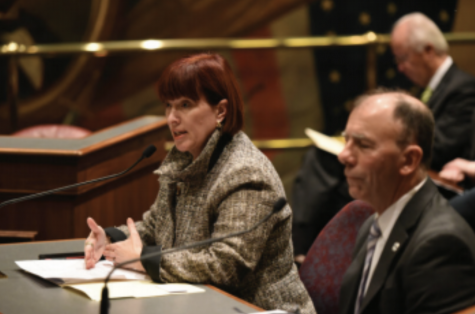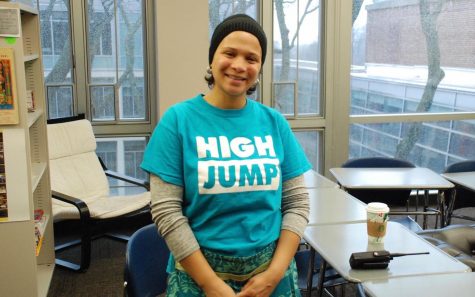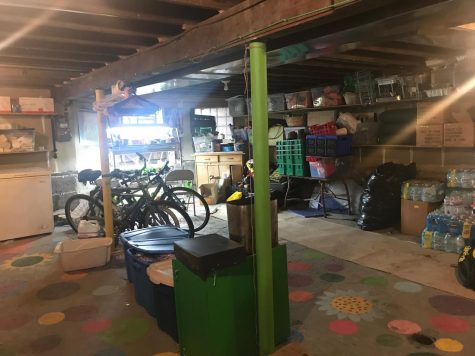Another Day, Another Meal
A Day in the Life of A Quest Cashier at Parker
During Conference on a Thursday, the cafeteria bustles with students toting to-go containers filled with homemade grilled cheese and tomato soup. Some grab a Naked smoothie from the cooler and a bagel from the bin by the salad bar, then head over to the checkout line, where the woman at the cash register greets each person with a brown-eyed glance and a “hi” as they enter their pin code. Some respond. Most don’t. At the end of the transaction, they exchange thank-yous. The student heads off to find a seat in the cafeteria with their friends or upstairs to a meeting–the cashier waits for the next person to approach.
Ashley Deoca has been in the cafeteria since 6 that morning stocking the space’s many nooks and crannies with everything from plastic water bottles to cream cheese and ringing up breakfasts for students, parents, and faculty/staff. When she is not busy behind the register, Deoca wheels carts of food and beverages back and forth from the kitchen to the tiled, fluorescently-lit area where students pick them up to enjoy for breakfast, lunch, or a snack.
“The first thing I do is I bring the register and everything else out,” Deoca said. “I prepare all the coffee creamers, I wash all the spoons, I grind the coffee–I make fresh coffee every day–take out all the stuff for the oatmeals, make sure all the waters, juices, and milks are stocked up, and then I am a cashier for the rest of the morning.”
Dressed in all black, a Quest logo stitched onto her shirt and her dirty blonde hair in a ponytail, Deoca hits the buttons on the right-hand cash register–a black, desktop-computer sized machine with a colorful display of touch-screen buttons arranged in rows and columns–with a rapidity attained by frequent practice: once someone enters their PIN code, she clicks “right,” followed by the type of food they purchased (breakfast, lunch special, or soup/salad, to name a few) then enters the specific item.
By 10:15 am, increasingly sparse clumps of students enter the cafeteria. The Conference rush is over, and the cafeteria clears out, students bringing what is left of their smoothies and muffins to their next classes. Deoca gets up to bring dirty utensils back to the dishwashing room.
Now Priscilla Rodriguez, who is wearing all black like Deoca but also dons a Quest apron, gets up from the long table at which she is eating breakfast to help transition the cafeteria from breakfast to lunch.
Rodriguez, who has worked at Parker since December 2015, starts her day at 8 am preparing cold sandwiches–“simple sandwiches”, as she calls them–of turkey and cheddar, ham and cheddar, and sunbutter and jelly. She then moves on to packaging cookies and restocking smaller, “snack-type” items such as chips and yogurts. This lasts until 11:00 am, when she starts at the cash register.
“My favorite part of my job here is being a cashier,” Rodriguez said. “Most of the students are really nice.” And when classes start to let out, she sits down at the left-hand register and starts ringing up food.
By 11:10, the cafeteria is coming alive, even though Upper School U-Lunch doesn’t technically start for five more minutes, and Middle Schoolers have another ten. Deoca is helping Abby Hanscom, a dietician who also works with Rodriguez and Deoca at the cash register, organize food labels. They notice how quickly Rodriguez’s line is filling up, and Deoca moves to her register to accommodate the influx of students as the clock approaches 11:15.
Class after class are dismissed, as evident by the increase in noise and bodies in the cafeteria. Hanscom, dressed in a floral blouse and jeans, grabs her iPad, which functions as a cash register for those with PIN codes only, and takes her place at Deoca’s right, close to the coffee creamers. The symphony of the beeping cash registers rivals the conversations of students and faculty grabbing their lunches and sitting down to eat.
Although Rodriguez estimates that between 400 and 500 people come by the registers each day, exchanges with the cashiers are usually brief, if at all existent. “I say hi,” eighth grader Camille Grant said, “and I say thanks, usually.”
That is the typical extent of the conversation at the cash registers during lunch rush, aside from cashiers’ asking Upper Schoolers about the contents of their to-go containers.
“Not a ton of students have conversations with us,” Hanscom said. “I could say that there are probably four or five kids whose faces and names I recognize. We have small talk, but that’s basically it.”
And the students keep coming. Much of the Upper School has H-break, and those students dart through the cafeteria alongside 7th and 8th graders, each vying for a spot in the checkout line.
Throughout the lunch rush, which, according to Rodriguez, is the hardest part of the job, there are moments of peace at the registers. 11:22 am. 11:49 am. 12:03 pm. Deoca, Hanscom, and Rodriguez take advantage of these moments, using them to help out the Quest staff in other ways. Rodriguez pitches in to clean up a spilled fruit cup. Deoca wheels a cart of chips and freshly-baked cookies out to the display area.
Yet almost as soon as these quieter moments begin, they are over. At 12:11 pm another wave of Upper Schoolers enters, jostling for space with the 4th, 5th, and 6th graders who also have their lunch period. Rodriguez finishes cleaning the fruit and takes over restocking for Deoca, who moves back to her register. Hanscom takes Rodriguez’s register on the left.
As the stream of students thins to a trickle, Hanscom, Deoca, and Rodriguez are able to once again take on more than operating the cash register. Deoca hands a bag of tortilla chips to a 5th grade boy in a wheelchair who can’t reach them. Rodriguez notices they are all gone and quickly heads back to the kitchen to restock.
At 12:38 pm, music teacher Alec Synakowski enters the cafeteria, which he frequents for coffee and tea. He greets Deoca, Rodriguez, and Hanscom, who are all back at the registers, by name and asks how each of them is doing this afternoon, then proceeds to ask what their plans are over the summer. Deoca, Rodriguez, and Hanscom all smile.
“You can really judge the character of people by how they treat people who may seem to have no effect on their lives, but in actuality they do,” Synakowski said. “And so if you can realize that, and realize that they are doing you such a service, they are doing the community such a service, treat them with the same kind of respect that you would anyone else.”
The last brownie is bought at 12:45 pm. The cafeteria is empty once again, an hour and forty-two minutes after its first hungry customer walked through the sliding wooden doors. Deoca and Rodriguez, diligent as ever, continue to clean up the cafeteria and restock for students who come in for an after-school snack.
At 1:13 pm the majority of the Quest staff sits down to lunch, which today is grilled cheese and tomato soup. At 2:00 pm Deoca leaves, making the 35-minute drive back to her home on the South Side.
Students finish up school beginning at 2:30 pm with Senior Kindergarteners who have “Late Day.” Hungry five- and six-year olds wander into the cafeteria in search of a cheese stick or a chocolate milk. By this time Hanscom has also left for the day, and Rodriguez is the lone cashier, as Deoca was that morning. She continues to ring up the food with a smile, as she has for nearly four hours, her high ponytail of black hair looking the same as it did when she arrived at 8 that morning.
Another burst of students arrives as 1st through 8th grades are dismissed at 3:10, with an increased sense of urgency–the cafeteria closes in a mere twenty minutes. Once they are all finished, snacks in hand, Rodriguez wheels the cooler/cash register shelf back inside the cafeteria, pushes the wooden doors closed, cleans up any deserted food or utensils, and is out the door by 4:15 pm.






